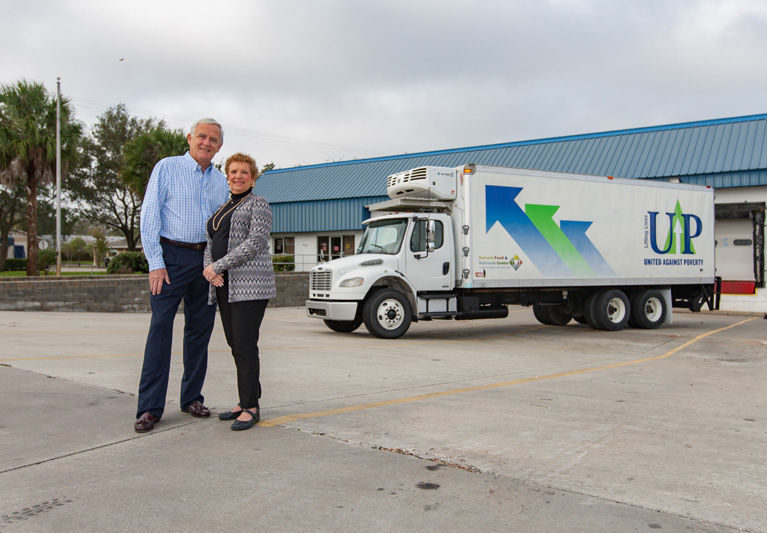
There are great things happening at Harvest Food and Outreach – you could even say things are looking UP. Over the next year the organization will be rolling out a new identity, United Against Poverty. The actual campuses where clients receive groceries and an array of services will be called UP Centers.
“Lifting Lives is the new tag line; the slogan for the organization. It’s what we do,” says Annabel Robertson, executive director of the Indian River County team. “People look at our (old) name and think we’re a food bank. We do so much more than food.
“Our goal with the new identity is to help people understand that our real mission is lifting lives – to empower and inspire those living in poverty to lift themselves to self-sufficiency. We believe that this identity, United Against Poverty, is a much more clear way of conveying that message.”
They have already launched an initial campaign around their campus – Harvest is going UP in 2016. Their Orlando and Fort Pierce locations are included in the new identity process and they have an eye on the future.
“Looking at our strategic plan, when we fully build out our centers, we are probably going to go into other communities,” says Jamie Jackson, director of institutional advancement. “We really needed to develop a brand that would work no matter what community we go into. We wanted something that would take us nationally.”
After a nationwide name, trademark and copyright search, they ascertained that the phrase is used nowhere else.
“We’re very excited,” says Robertson. “United Against Poverty really does sound like a brand you would think has already been used. And it hasn’t. It’s ours. It’s just been waiting for us.”
Also waiting for them was a choice new location that will enable them to double the size of the Cost Share Grocery program and the number of clients served, and also provide space for an additional 12 to 16 collaborative partners serving the same population.
Expanding the current campus, where Harvest holds a mortgage on the Life Enrichment Center and lease the Cost Share Grocery building, was not an option because of insufficient parking and other issues. A cost analysis confirmed that the move would ultimately result in the availability of greater programming funds.
“We are currently providing service in just under 20,000 sq. ft. and that’s 40,000 sq. ft.,” says Robertson of the new space. “It effectively doubles the size. . . . It will certainly increase our capacity to serve 1,000 people a day in the new center.”
The quiet phase of a Capital Campaign chaired by Don Drinkard, who has been replaced as board chairman by Barbara Lowry, is currently underway. Located directly across the railroad tracks from their current Life Enrichment Center on U.S. 1, the building most recently housed Hale Groves Southern Fulfillment Services, but longtime Vero residents will remember it as Scottie’s. Architects from Moor Baker and Associates are assisting in the vision planning phase.
Ideally situated, the building is within walking distance of the Treasure Coast Homeless Services Council, Economic Opportunities Council of IRC, IRC Health Department, IRC Veterans Services, and the County Administration complex.
Collaborative partnerships continue to develop. Several nonprofits have expressed an interest in having space at the new UP Center, recognizing that people may not be aware of the services they provide.
In Indian River County, Access Florida, the Department of Children and Families division that administers food stamps, temporary cash assistance and Medicaid, is located on their campus. There is a 30-day delay between applying for food stamps and receiving them, and during that time United Against Poverty (Harvest) can assist through its Crisis Care and Emergency Food Pantry.
Clients often come to them having hit rock bottom, and during the crisis stabilization process case manager John Porta Jr. assists with whatever issues are causing their financial instability.
“Our goal is to connect them with resources; either resources we can provide here or through our partners,” said Robertson, noting it could be anything from job training and childcare to health and mental health care. “We believe very strongly in not reinventing the wheel. Our model is to provide a holistic approach.”
Through the Cost Share Grocery program individuals are able to purchase most of their groceries at roughly one-third the cost of a standard grocery store. Clients can earn extra purchasing power by attending classes or by volunteering at their campus or at partner nonprofits.
The group’s HOPE (Harvest Outreach Preparation for Employment) program, now renamed STEP (Success Training Employment Program), offers individuals a one- to three-year job training relationship.
“Most of these people have very weak work histories, so they’re not going to start in anyplace other than entry level,” says Jackson. “We take them from that entry level point and work with them to the stage where they can progress.”
Ongoing job coaching support and a 40-hour Emotional Intelligence curriculum, similar to the leadership training utilized by Fortune 500 companies, have been developed to help people not only achieve but retain employment.
“Job retention is really a critical issue for employers and that’s what we’re trying to help people with. Change. Systemic change,” stresses Robertson.
“These are all things that we currently do. We’re doing a really strong job; a good job of creating a scalable model that’s truly impactful,” says Robertson. “Our opportunity in our new building is to serve more people in a more efficient way.”
The group is working with the University of Florida to provide an independent third-party statistical analysis of the progress of their job training program, and to develop a return on investment analysis for donors.
“Our goal is that our donors will be able to see very clearly the effectiveness of the impact of their contributions,” explains Robertson. “We’re very data driven in all our departments in being able to track our services; what’s provided to our clients. We’ve made tremendous advances over the past three years in data collection and analysis and now our goal is to have a third party come in to verify our successes.”
“Our primary goal is for people to lift themselves to economic self-sufficiency; that means no government benefits,” adds Jackson. “We also have to be able to measure incremental progress to make sure they make that goal. All of this data is not only for donors. It’s also so that we can track the progress of the people that we serve so that we know that they’re moving forward. We’re actually monitoring them periodically to see how they’re doing and to identify services they may need. We don’t just drop them.”



